Do you have a question about the BD BACTEC FX and is the answer not in the manual?
Describes the purpose of the BD BACTEC™ FX instrument for detecting bacteria and fungi.
Explains the mechanism of microbial growth detection using fluorescence in culture vials.
Details the major features and configurations of the BD BACTEC FX instrument.
Provides a comprehensive overview of the instrument's automated detection system and its components.
Lists the controllers responsible for instrument analysis and operation, including temperature and agitation.
Describes the subsystem designed to maintain optimal temperature for culture vial contents.
Explains how vials are agitated to ensure homogeneous distribution of nutrients and by-products.
Details the subsystem that optically activates vial sensors and collects fluorescent light.
Details the instrument's color Liquid Crystal Display and its touchscreen functionality.
Explains the audible alarm's function for system alerts and positive vials, including loudness settings.
Describes the location and function of barcode scanners for vial identification and accession scanning.
Lists and describes the various media types available for use with the BD BACTEC FX system.
Explains the initial built-in test performed by subsystems to ensure proper operation upon power application.
Details the instrument's testing cycle, including light, temperature, and dark readings, and positivity algorithms.
Guides the user on how to best utilize the manual for instrument operation and maintenance.
Explains conventions used in the manual for clarity, such as screen button formatting and typeface.
Identifies and illustrates the various symbols and connection ports found on the BD BACTEC FX instrument.
Explains the significance of NOTES, CAUTIONS, and WARNINGS presented in the manual.
Introduces the section that describes the meaning and use of instrument controls and indicators.
Details the location and operation of the instrument's power switch.
Describes the location and meaning of the system indicators that display instrument states.
Describes the location and operation of the drawer handles for accessing instrument compartments.
Details the location and operation of the instrument's barcode scanners for vial identification.
Describes the location and operation of the instrument's Liquid Crystal Display and touchscreen.
Describes the LED indicators at each station that provide vial or station status information.
Describes the location and primary purposes of the instrument's USB ports.
Explains the variety of sounds generated by the instrument to inform users of operational states.
Describes how alphanumeric fields activate an onscreen keyboard for data entry.
Introduces the section on routine operation of the BD BACTEC FX instrument.
Provides instructions for routine operation of the instrument using its interface.
Explains how the LCD presents information and how to interact with touchscreen elements for operations.
Describes the main display showing instrument and station status, and initiating activities.
Defines vial and station statuses and how they are indicated on displays and through icons.
Outlines the simple daily maintenance procedures to ensure reliable instrument performance.
Details the procedures for entering vials into the instrument using two different methods.
Explains how to recall, enter, and modify patient, specimen, and vial data within the instrument.
Explains the automatic and continuous nature of vial testing, including interruption conditions.
Guides users on the procedures for removing positive and negative vials, including single and batch removal.
Introduces the reference material covering the instrument's user interface screens, icons, reports, and functions.
Presents a hierarchical list of instrument displays and functions with cross-references to detailed sections.
Provides general information about system and station status, and lists operations initiated from the Status display.
Describes the display that appears when initiating the remove positive vials activity.
Details the display shown when initiating the remove negative vials activity.
Explains the display that enables identification of ongoing and positive anonymous vials.
Describes the display used for entering vials into the instrument and the current drawer status.
Shows a list of system alerts that have occurred, including their details and management options.
Provides an iconic view of all drawer stations, showing the status of each station dynamically.
Displays patient-related information for specimens and is used for searching attached patient records.
Enables adding or recalling information on specimens (accessions) and managing vial associations.
Used to view or enter information about individual vials and perform specialized vial functions.
Enables generating line graphs or plots of test readings for specified non-pending stations.
Lists the reports available for printing and how to access the Reports menu.
Lists vials with incubation or test reading failures within the last 30 days.
Lists the latest 100 instrument alerts with details on time, description, and status.
Reports on drawer temperatures, blocked stations, and maintenance activities.
Introduces the maintenance procedures for the instrument, including test and utilities functions.
Enables performance of daily instrument maintenance tests, checking indicators, and printing reports.
Allows blocking or unblocking stations in drawers, often due to indicator failures.
Provides access to utilities like software upgrades, saving data, rebooting, and password changes.
Explains how to reboot the main FX computer to restore communications.
Guides users on how to change the Supervisor password.
Outlines the configuration settings accessible through different displays like Lab, Reports, Instrument, LIS, and Time.
Refers to Section 2.4.1 for detailed information on the Configuration - Lab display settings.
Refers to Section 2.4.2 for detailed information on the Configuration - Reports display settings.
Refers to Section 2.4.5 for detailed information on the Configuration - Time display settings.
Highlights the system's low maintenance requirements and the need for authorized service personnel for complex tasks.
Outlines daily maintenance procedures to ensure reliable performance.
Lists specific daily checks for indicators, temperature, and printer supply.
Covers maintenance tasks performed based on specific needs or conditions.
Details how to block stations that fail indicators or do not detect vials correctly.
Explains the importance of clean air filters and how to clean or replace them.
Lists the functions accessible through the Maintenance – Utilities menu.
Details the process for upgrading the instrument software via USB.
Explains how to save the vial database and event log files to a flash drive.
Advises on initial troubleshooting steps and when to contact local BD representatives for service.
Discusses error messages and codes, including their possible causes and corrective actions.
Addresses conditions where stations are unusable, vials are affected, or vials are partially seated.
Details how hardware issues mark stations as Unusable to prevent incorrect test readings.
Explains how alerts can lead to vials being marked as Affected, recommending subculturing for optimal recovery.
Addresses messages indicating potentially partially seated vials and how to resolve them.
Provides guidance on configuring another instrument's barcode reader if one malfunctions.
| Category | Laboratory Equipment |
|---|---|
| Manufacturer | BD (Becton, Dickinson and Company) |
| Incubation | Continuous |
| User Interface | Touchscreen |
| Dimensions | Varies by model |
| Weight | Varies by model |
| Power Requirements | 100-240V AC, 50/60Hz |
| Detection Technology | Fluorescence |
| Connectivity | LIS Connectivity |
| Sample Types | Blood, Sterile Body Fluids |
| Capacity | Varies by model (e.g., FX40, FX80, FX200) |
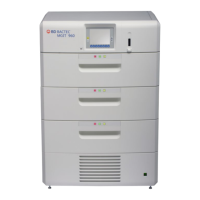
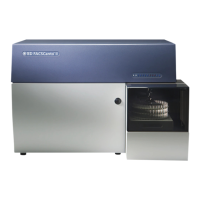
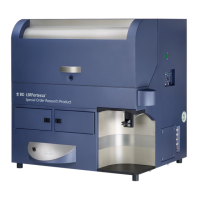
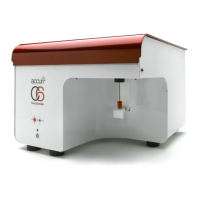
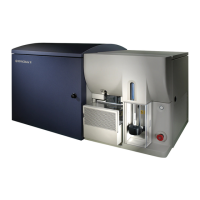
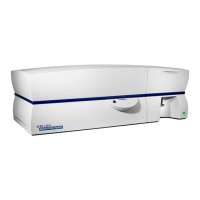
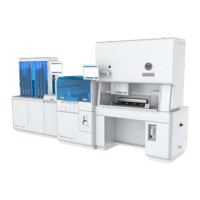
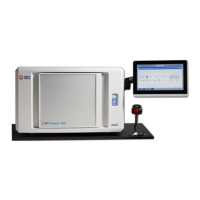
